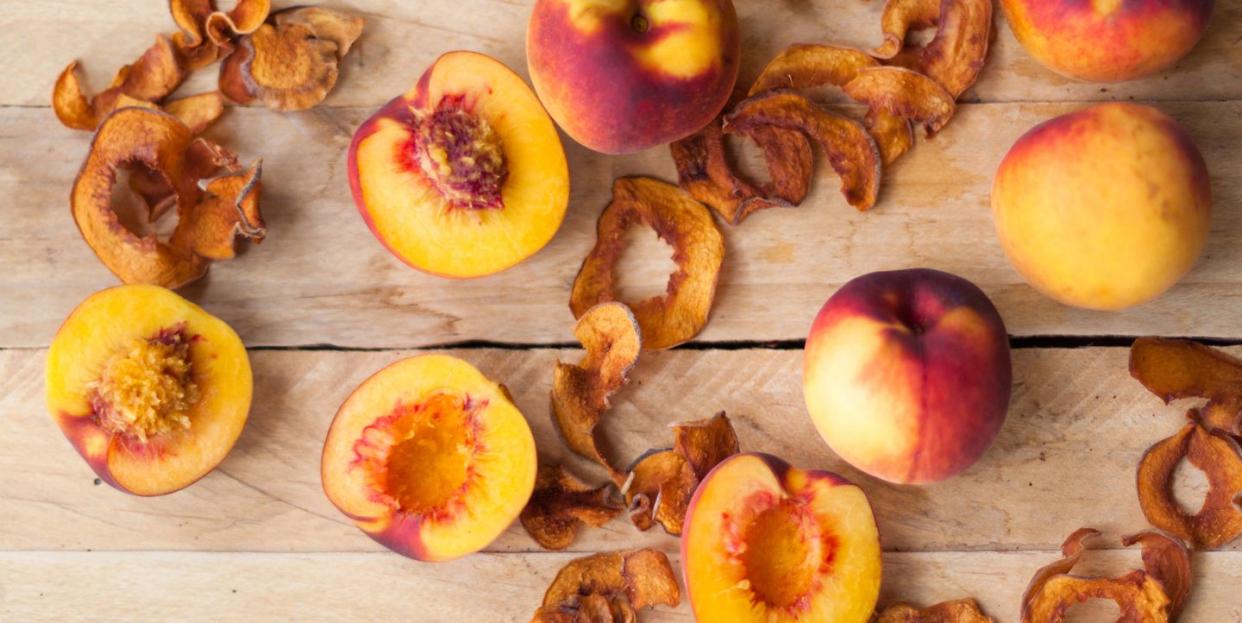You Can Make Your Food Last Way Longer By Using One Of These Methods

Honest question: What do you do with your nearly-spoiled meat and produce? Like, the ones that aren’t quite expired yet, but if you wait any longer to eat them you might find your fridge full of moldy veggies or smelly chicken. (Ew.) Answer: You freeze-dry or dehydrate them, of course!
Whether you’re deeply familiar with freeze-drying or dehydrating or you've heard the terms, but never really knew what they meant (Read: Your 12-in-1 pressure cooker has a dehydrating function you don't know what to do with), there’s a lot to learn about the difference between the two. Each has pros and cons.
But, one of the biggest pros to freeze-drying and dehydrating foods is that they’re great for storage purposes. For example, you can bring freeze-dried or dehydrated foods on a long road trip or hike without them going bad.
These food preservation methods have become even more popular now, says Kero Gans, RDN. “I think people are more into having food that they can keep in their pantry and not have to worry about it spoiling. They don’t want to worry about getting to a supermarket — especially during a pandemic."
So, if you’re curious about the differences between dehydrating and freeze-drying foods, the history of the practices, the respective benefits, and more, keep reading. The following is everything you need to know about freeze-drying versus dehydrating foods, according to an RD.
What’s the history of dried foods?
Dried foods aren’t exactly a new thing. The practice has been around for years—like, thousands of years, Gans explains, dating back to around 12,000 BC. Similar to today’s purposes, humans in this era utilized dehydrated foods to store sustenance for longer periods of time. (Picture them stocking up on food for winter when it might be more difficult to hunt or gather fruits and vegetables.)
And of course, back then, people were using the sun’s rays, fire, and smoke to dry and preserve goods, says Gans. Nowadays, many people rely on technology to create dried food, and freeze-drying specifically is a pretty new-ish technique. (It was invented around the early 1900's.)
What’s the difference between freeze drying and dehydrating?
The major difference between freeze-drying and dehydrating is this: Freeze-dried foods have a longer shelf life than dehydrating items, Gans says.
That's because freeze-drying removes about 98 percent of the water in foods. This is done via a large freezer, which covers the food in ice crystals. Then, the food is vacuum-sealed very slowly by evaporating the existing water for optimal freshness.
Dehydrating foods, however, removes only about 80 percent of the water, and typically does not involve vacuum-seal technology, Gans explains. (And ICYMI, the presence of water is what causes foods to grow moldy, bacteria-ridden, and decompose.)
Food dehydration is typically done in the sun or via air-drying, Gans says, but there are also dehydration machines and ovens that work by circulating air at very high temperatures to draw the moisture out of food.
Both methods tend to alter the natural taste of food ever-so-slightly (though there’s usually a textural difference, too), with freeze-drying being the better method for preserving a food’s usual flavor and smell, Gans notes.
What are the benefits of freeze-drying food?
TL;DR, there are a lot of benefits to freeze-drying your food. Among other things, freeze-drying typically makes food lighter in weight, Gans says, which means it's easier to carry around in your hiking backpack or go-bag than dehydrated food, which retains more of its weight.
And yep, freeze-dried food is also better for preserving inherent nutrients and minerals, Gans says. “Think about it, you usually freeze-dry food at its peak ripeness,” she explains. “Basically, you are locking in the nutrients and taste."
Dehydrated foods, on the other hand, lose about half of the nutrients during the heating-heavy moisture-removal process. You can also freeze-dry just about any food out there—like dairy products, eggs, grains, etc.—whereas dehydrated foods are more limited in scope.
What are the benefits of dehydrating food?
Again, dehydrating food removes about 80 percent of the water in a food item, which means that even though it’s not quite as long-lasting as freeze-drying, it’s still a great method for preserving produce you know you can’t use right away, Gans says. There’s a reason people have been practicing dehydrating food for thousands of years.
And TBH, if you love buying snacks like dried fruit or cured meats (hi, charcuterie boards), it’s likely that those items are a result of dehydration. “Dried fruit is essentially dehydrated fruit, with manufacturers sometimes adding extra sugars for sweetness,” Gans says.
Now that you’re more caught up on the ins and outs of freeze-drying versus dehydrating foods, it’s time to stock up on your preferred method. See options for both DIY-ing your snacks, or just taking the store-bought route.
You Might Also Like

